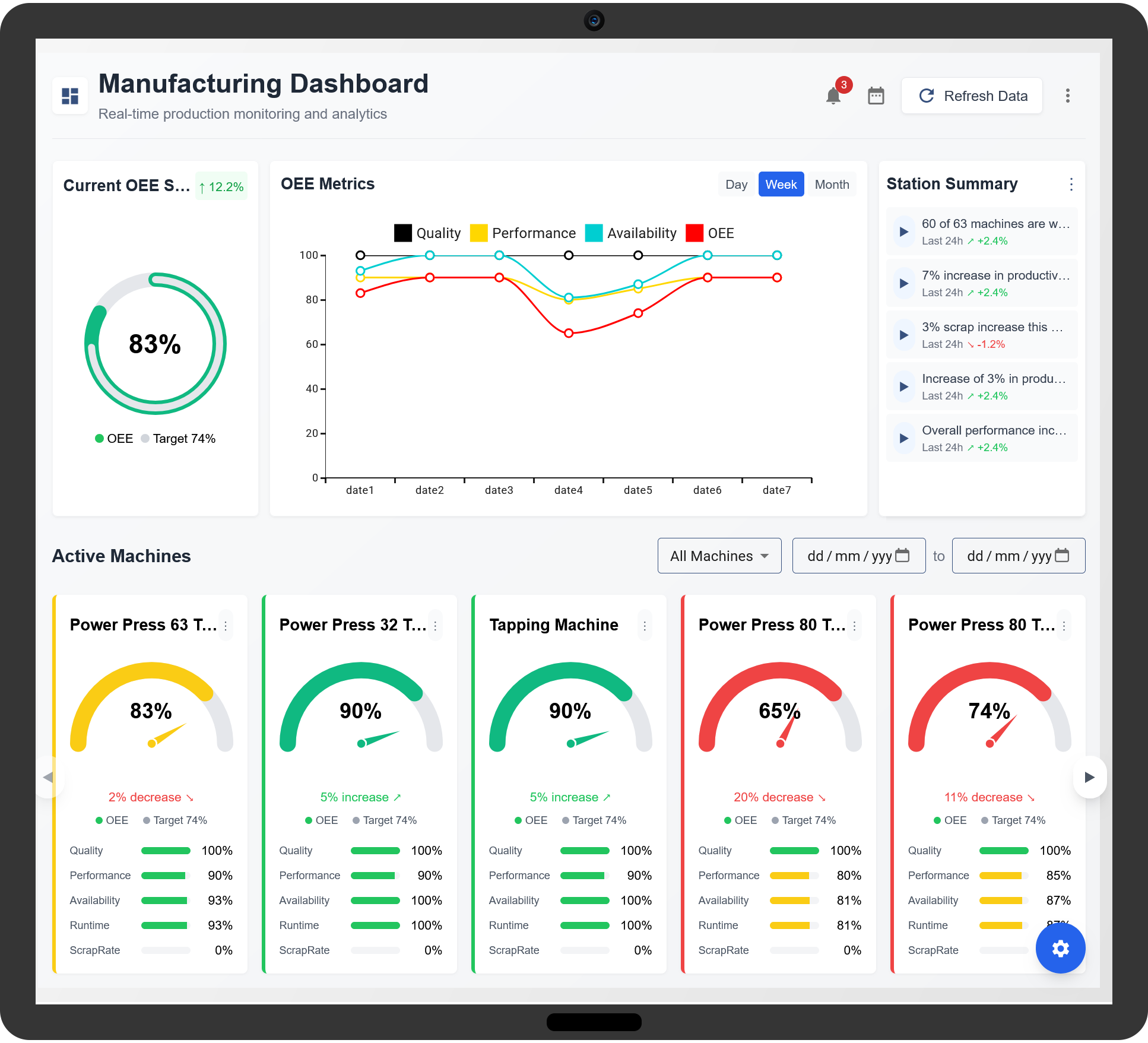Overall Equipment Effectiveness (OEE) is a key performance metric used in manufacturing to assess how efficiently equipment is utilized. It is calculated based on three critical factors: Availability, Performance, and Quality. By measuring OEE, manufacturers can identify areas of improvement, reduce downtime, and optimize production processes. Implementing an effective OEE measurement strategy ensures that resources are maximized, leading to improved efficiency and profitability.

1. Understanding OEE Components
OEE is a comprehensive metric that provides insight into equipment efficiency. It is calculated using the following three factors:
- Availability: Measures the percentage of scheduled time that equipment is available for production. Downtime, both planned and unplanned, affects this metric.
- Performance: Evaluates how well the equipment operates compared to its maximum potential speed.
- Quality: Assesses the proportion of defect-free products produced during a manufacturing cycle.
The OEE formula is:
OEE (%) = Availability × Performance × Quality
2. How to Accurately Measure OEE
Measuring OEE effectively requires a structured approach that involves data collection, analysis, and continuous improvement strategies.
Step 1: Define Measurement Goals
Establish clear objectives for measuring OEE. Determine whether the focus is on reducing downtime, improving cycle time, or minimizing defects. Setting precise goals helps in designing an effective OEE monitoring system.
Step 2: Collect Reliable Data
Accurate data collection is crucial for calculating OEE. Utilize automated sensors, machine logs, and operator input to gather real-time data on machine availability, speed, and production quality.
Step 3: Calculate Availability
Availability is determined by tracking total production time and subtracting downtime. The formula is:
Availability (%) = (Total Run Time / Planned Production Time) × 100
Step 4: Measure Performance
Performance considers the actual operating speed versus the ideal speed. The calculation is:
Performance (%) = (Actual Output / Ideal Output) × 100
Step 5: Assess Quality
Quality measures the percentage of defect-free products. It is calculated as:
Quality (%) = (Good Products / Total Products) × 100
Step 6: Analyze OEE Score
Once all three components are measured, multiply them to determine the final OEE score. Compare the result to industry benchmarks to identify areas for improvement.
3. Benefits of OEE Measurement
Effectively measuring OEE provides valuable insights into production efficiency and helps in making data-driven decisions.
- Reduced Downtime: Identifies causes of machine stoppages.
- Increased Productivity: Enhances overall manufacturing efficiency.
- Higher Quality Output: Minimizes defects and waste.
- Better Resource Utilization: Maximizes the use of available equipment.
4. Common Challenges in Measuring OEE
Despite its advantages, OEE measurement comes with challenges that need to be addressed for accurate results.
- Data Inconsistency: Inaccurate data collection can lead to misleading OEE calculations.
- Resistance to Change: Employees may resist adopting new OEE tracking methods.
- Complex Analysis: Interpreting OEE data requires expertise to derive actionable insights.
5. Strategies for OEE Improvement
After measuring OEE, the next step is implementing strategies to enhance efficiency.
- Reduce Unplanned Downtime: Implement preventive maintenance programs.
- Optimize Machine Speed: Adjust production settings to maintain optimal performance.
- Improve Quality Control: Introduce better inspection methods to reduce defects.
- Enhance Operator Training: Educate staff on best practices to maximize OEE.
6. Future of OEE Measurement
With advancements in technology, OEE measurement is becoming more sophisticated, allowing manufacturers to gain deeper insights into production efficiency.
- AI-Powered Analytics: Machine learning helps predict inefficiencies before they occur.
- Real-Time Dashboards: Live monitoring systems provide instant performance updates.
- Automation Integration: Automated data collection minimizes human errors.
By effectively measuring and continuously improving OEE, manufacturers can enhance production efficiency, reduce operational costs, and maintain a competitive advantage in the industry.
Effectively Measure Overall Equipment Effectiveness
What is Overall Equipment Effectiveness (OEE)?
OEE is a key performance metric used to measure the efficiency of manufacturing equipment by evaluating availability, performance, and quality.
Why is OEE important in manufacturing?
OEE helps manufacturers identify inefficiencies, reduce downtime, and improve overall productivity, leading to better operational performance.
What are the three key factors of OEE?
The three key factors of OEE are availability (uptime vs. downtime), performance (speed and efficiency), and quality (defect-free production).
How is OEE calculated?
OEE is calculated using the formula: OEE = Availability × Performance × Quality, expressed as a percentage.
What is considered a good OEE score?
An OEE score of 85% or higher is considered world-class, while 60-85% is typical for most manufacturing operations.
How can downtime impact OEE?
Downtime reduces availability, which lowers the overall OEE score and decreases production efficiency.
What role does performance efficiency play in OEE?
Performance efficiency measures how well equipment runs at optimal speed. Slow cycles or minor stops reduce OEE.
How does quality affect OEE measurement?
Quality measures the percentage of defect-free products. Higher defects lower the OEE score, affecting productivity.
What are the main causes of low OEE?
Low OEE is often caused by machine breakdowns, slow cycle times, quality defects, and unplanned downtime.
How can real-time monitoring improve OEE?
Real-time monitoring helps track machine performance, detect inefficiencies, and take corrective actions to maintain optimal OEE.
What tools are used to measure OEE?
OEE measurement tools include software platforms, real-time sensors, and automated reporting systems for accurate data collection.
How can predictive maintenance improve OEE?
Predictive maintenance minimizes unexpected failures, reduces downtime, and keeps machines operating at peak performance.
How does OEE help in continuous improvement?
OEE provides data-driven insights that help identify areas for process optimization and efficiency improvements.
Can OEE be applied to different industries?
Yes, OEE can be applied across industries such as manufacturing, logistics, and healthcare to improve efficiency.
What strategies can be used to improve OEE?
Strategies include preventive maintenance, automation, employee training, and real-time performance monitoring.